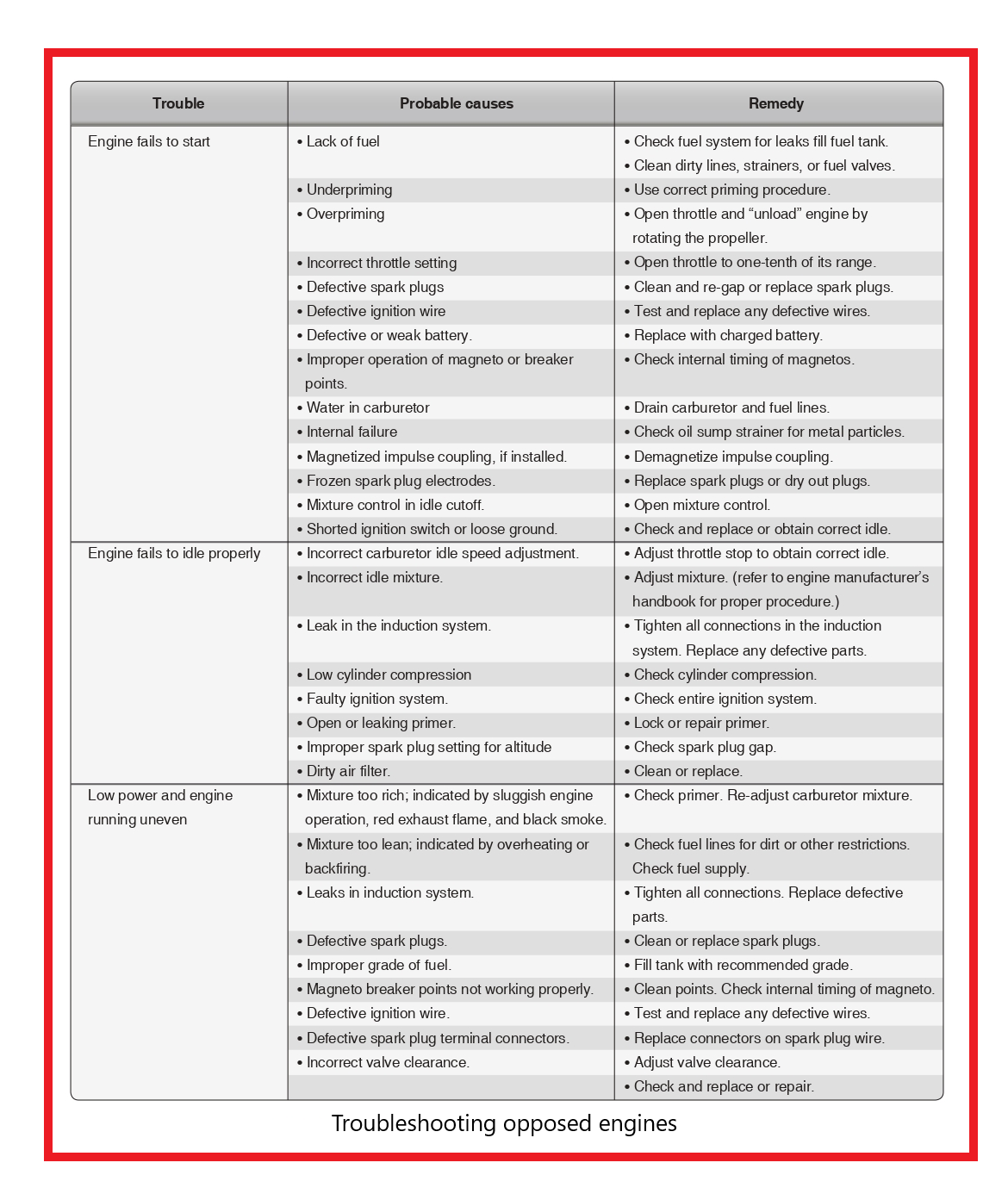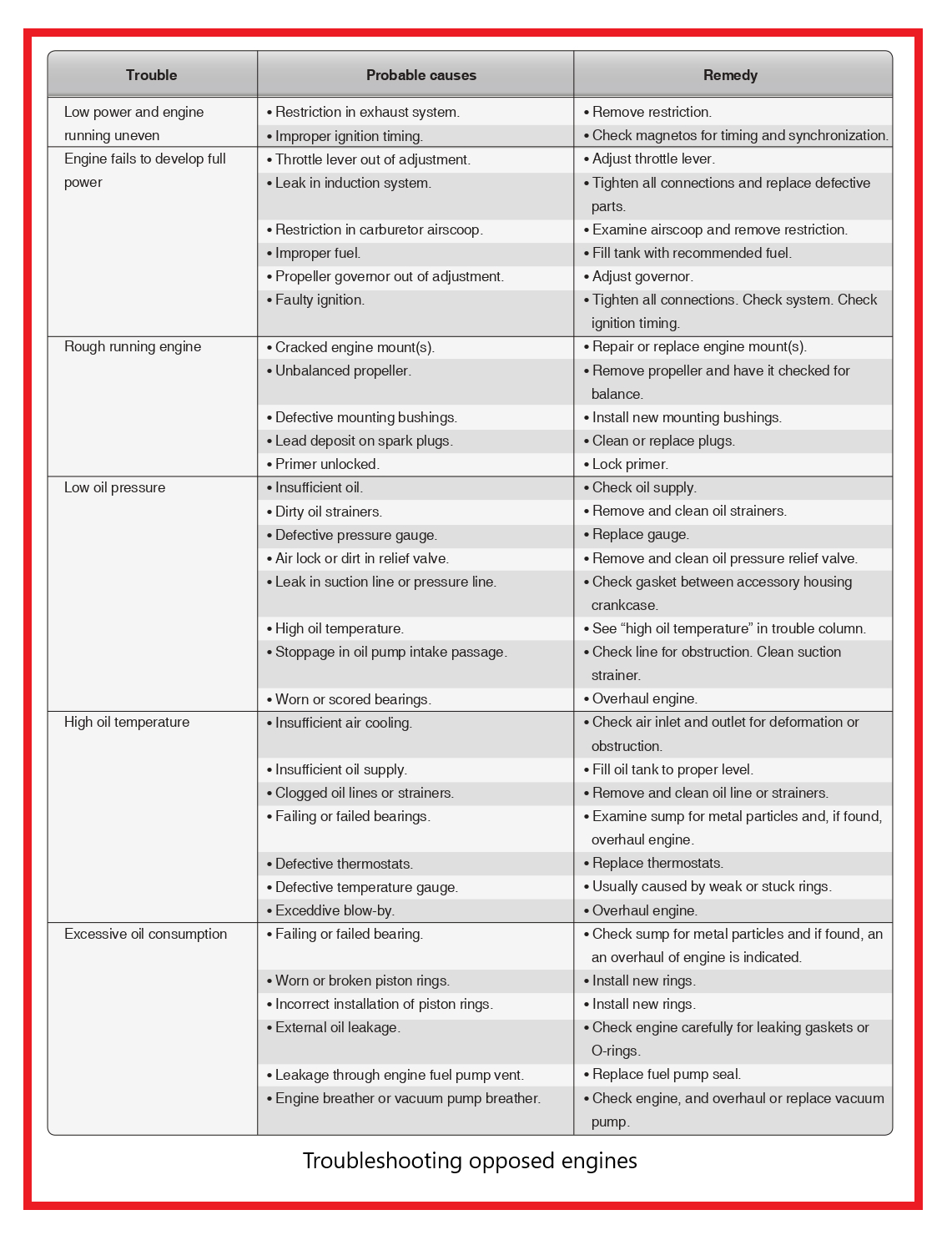Troubleshooting is a systematic analysis of the symptoms that indicate engine malfunction. It would be impractical to list all the malfunctions that could occur in a reciprocating engine, so only the most common malfunctions are discussed. A thorough knowledge of the engine systems, applied with logical reasoning, solves most problems that may occur.
Figure lists general conditions or troubles that may be encountered on reciprocating engines, such as engine fails to start. They are further divided into the probable causes contributing to such conditions. Corrective actions are indicated in the remedy column. The items are presented with consideration given to frequency of occurrence, ease of accessibility, and complexity of the corrective action indicated.
The need for troubleshooting normally is dictated by poor operation of the complete powerplant. Power settings for the type of operation at which any difficulty is encountered, in many cases, indicate that part of the powerplant that is the basic cause of difficulty.
The cylinders of an engine, along with any type of supercharging, form an air pump. Furthermore, the power developed in the cylinders varies directly with the rate that air can be consumed by the engine. Therefore, a measure of air consumption or airflow into the engine is a measure of power input. Ignoring for the moment such factors as humidity and exhaust back pressure, the manifold pressure gauge and the engine tachometer provide a measure of engine air consumption. Thus, for a given rpm, any change in power input is reflected by a corresponding change in manifold pressure.
The power output of an engine is the power absorbed by the propeller. Therefore, propeller load is a measure of power output. Propeller load, in turn, depends on the propeller rpm, blade angle, and air density. For a given angle and air density, propeller load (power output) is directly proportional to engine speed. The basic power of an engine is related to manifold pressure, fuel flow, and rpm. Because the rpm of the engine and the throttle opening directly control manifold pressure, the primary engine power controls are the throttle and the rpm control. An engine equipped with a fixed-pitch propeller has only a throttle control. In this case, the throttle setting controls both manifold pressure and engine rpm.
With proper precautions, manifold pressure can be taken as a measure of power input, and rpm can be taken as a measure of power output. However, the following factors must be considered:
1. Atmospheric pressure and air temperature must be considered, since they affect air density.
2. These measures of power input and power output should be used only for comparing the performance of an engine with its previous performance, or for comparing identical powerplants.
3. With a controllable propeller, the blades must be against their low-pitch stops, since this is the only blade position in which the blade angle is known and does not vary. Once the blades are off their low-pitch stops, the propeller governor takes over and maintains a constant rpm, regardless of power input or engine condition. This precaution means that the propeller control must be set to maximum or takeoff rpm, and the checks made at engine speeds below this setting.
Having relative measures of power input and power output, the condition of an engine can be determined by comparing input and output. This is done by comparing the manifold pressure required to produce a given rpm with the manifold pressure required to produce the same rpm at a time when the engine (or an identical powerplant) was known to be in top operating condition.
An example shows the practical application of this method of determining engine condition. With the propeller control set for takeoff rpm (full low blade angle), an engine may require 32 inches of manifold pressure to turn 2,200 rpm for the ignition check. On previous checks, this engine required only 30 inches of manifold pressure to turn 2,200 rpm at the same station (altitude) and under similar atmospheric conditions. Obviously, something is wrong; a higher power input (manifold pressure) is now required for the same power output (rpm). There is a good chance that one cylinder has a malfunction.
There are several standards against which engine performance can be compared. The performance of a particular engine can be compared with its past performance, provided adequate records are kept. Engine performance can be compared with that of other engines on the same aircraft or aircraft having identical installations.
If a fault does exist, it may be assumed that the trouble lies in one of the following systems: 1. Ignition system 2. Fuel-metering system 3. Induction system 4. Power section (valves, cylinders, etc.) 5. Instrumentation.
If a logical approach to the problem is taken and the instrument readings properly utilized, the malfunctioning system can be pinpointed, and the specific problem in the defective system can be singled out.
The more information available about any particular problem, the better the opportunity for a rapid repair. Information that is of value in locating a malfunction includes: 1. Was any roughness noted? Under what conditions of operation? 2. What is the time on the engine and spark plugs? How long since last inspection? 3. Was the ignition system operational check and power check normal? 4. When did the trouble first appear? 5. Was backfiring or afterfiring present? 6. Was the full throttle performance normal?
From a different point of view, the powerplant is, in reality, a number of small engines turning a common crankshaft and being operated by two common phases: fuel metering and ignition. When backfiring, low power output or other powerplant difficulty is encountered, first find out which system, fuel metering or ignition, is involved and then determine whether the entire engine or only one cylinder is at fault. For example, backfiring normally is caused by: 1. Valves holding open or sticking open in one or more of the cylinders 2. Lean mixture 3. Intake pipe leakage 4. An error in valve adjustment that causes individual cylinders to receive too small a charge or one too large, even though the mixture to the cylinders has the same fuel/air ratio.
Ignition system reasons for backfiring might be a cracked distributor block or a high-tension leak between two ignition leads. Either of these conditions could cause the charge in the cylinder to be ignited during the intake stroke. Ignition system troubles involving backfiring normally are not centered in the basic magneto, since a failure of the basic magneto would result in the engine not running, or it would run well at low speeds but cut out at high speeds. On the other hand, replacement of the magneto would correct a difficulty caused by a cracked distributor where the distributor is a part of the magneto.
If the fuel system, ignition system, and induction system are functioning properly, the engine should produce the correct bhp unless some fault exists in the basic power section.
Valve Blow-By
Valve blow-by is indicated by a hissing or whistle when pulling the propeller through prior to starting the engine, when turning the engine with the starter, or when running and blow-by past the intake valve is audible through the carburetor.
Correct valve blow-by immediately to prevent valve failure and possible engine failure by taking the following steps:
1. Perform a cylinder compression test to locate the faulty cylinder.
2. Check the valve clearance on the affected cylinder. If the valve clearance is incorrect, the valve may be sticking in the valve guide. To release the sticking valve, place a fiber drift on the rocker arm immediately over the valve stem and strike the drift several times with a mallet. Sufficient hand pressure should be exerted on the fiber drift to remove any space between the rocker arm and the valve stem prior to hitting the drift.
3. If the valve is not sticking and the valve clearance is incorrect, adjust it as necessary.
4. Determine whether blow-by has been eliminated by again pulling the engine through by hand or turning it with the starter. If blow-by is still present, it may be necessary to replace the cylinder.



